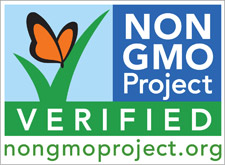Non-GMO Project Verification: What does it mean?
by Chris Keefe
This article was originally published in October 2012

Until labels for genetically modified organisms (GMOs) become mandatory, we have two voluntary labels for GMO avoidance — certified organic and Non-GMO Project Verified.
You’ve seen the colorful butterfly logo designating Non-GMO Project verification on food packages and shelf tags at PCC. But have you wondered what process food companies and farmers go through to become “Non-GMO Project Verified”?
In honor of National Non-GMO Month, we want to explain what verification entails and why vendors say it’s worth it.
The Non-GMO Project is North America’s only independent, third-party certifier to ensure non-GMO claims are backed up by Best Practices and testing throughout the supply chain. Since 2009 the Project has verified more than 5,000 products. More than 1,140 are sold at PCC.
“We were totally unaware of what GMOs were until a grocery retailer questioned us on whether we were verified non-GMO,” says Doug Foreman, founder and chairman of Beanitos, which sells black bean chips at PCC.
“This was an eye-opening moment,” he says. “We found an abundance of evidence revealing possible problems with genetic modification in our food supply and immediately began the process of verification.”
Committing to non-GMO
The Non-GMO Project Verified seal on a package indicates the product is compliant with the project’s standards, which require producers to meet stringent GMO testing, segregation and traceability. That pretty seal with the butterfly represents a significant commitment.
To become Non-GMO Project Verified, a manufacturer, farmer or restaurateur first must share information that enables the project’s technical advisors to identify high-risk ingredients and opportunities for contamination in processing facilities. The project then sketches out what verification will entail and estimates the cost of verification for that company.
As a mission-driven nonprofit, the Non-GMO Project works to keep the cost of verification as low as possible. After all, the more non-GMO options, the better for consumers.
Companies seeking verification must provide hard data about the products they enroll, including ingredient lists, production facility information, and test results from approved laboratories. The Project’s independent technical advisor, FoodChain, then begins the review process.
Steps in verification
Brian Ray of Garden of Life is astonished by the amount of work that goes into verifying the company’s multivitamins. They can contain 50 to 60 ingredients and each one requires review.
“The Non-GMO Project auditors are extremely thorough,” he says. “Even though we collect certifications from every supplier, verifying that each ingredient is GMO-free, the auditors work up the food chain. They challenge each statement and require that suppliers prove through adequate agricultural controls and regular DNA testing that GMOs are not introduced unintentionally.”
For companies with low-risk ingredients, the process can be much simpler.
“The process itself took just a few months to complete,” says Beanitos’ Doug Foreman. “The longest part was waiting for our suppliers’ third-party lab tests, proving their commitment to sourcing non-GMO ingredients. One of our seasoning suppliers couldn’t guarantee the milk in our cheddar was sourced from hormone-free cows. We subsequently moved to a supplier that is just as dedicated to non-GMO as we are.”
If a product contains only low-risk ingredients that don’t have GMO varieties on the market, testing is not required. FoodChain conducts a thorough review of ingredient specification sheets to ensure there’s no risk of GMOs.
For companies using high-risk ingredients — such as corn, soy and beet sugar — the Non-GMO Project standard requires ongoing testing of those ingredients. Any ingredient testing above 0.9 percent GMO (the same threshold required in Europe and by Washington’s I-522) is not allowed. After testing, ingredients must remain segregated and traceable from that point on. This ensures ingredient integrity through to the finished product. Manufacturers also must pass on-site inspections of any facility using high-risk ingredients.
Look for the butterfly
Upon successful completion of the verification process, the manufacturer may start using the Non-GMO Project Verified seal on packaging. Even at this point, however, manufacturers who have committed to verification aren’t off the hook. They must continue testing every single batch of high-risk ingredients and complete an audit process annually to remain verified.
As you shop PCC this October, keep an eye out for the many verified products. Several are on sale this month.
By supporting manufacturers who have committed to Non-GMO Project Verification, we support farmers committed to growing non-GMO foods and send a powerful message about what we want on our tables.
Chris Keefe is the outreach coordinator for the Non-GMO Project.
